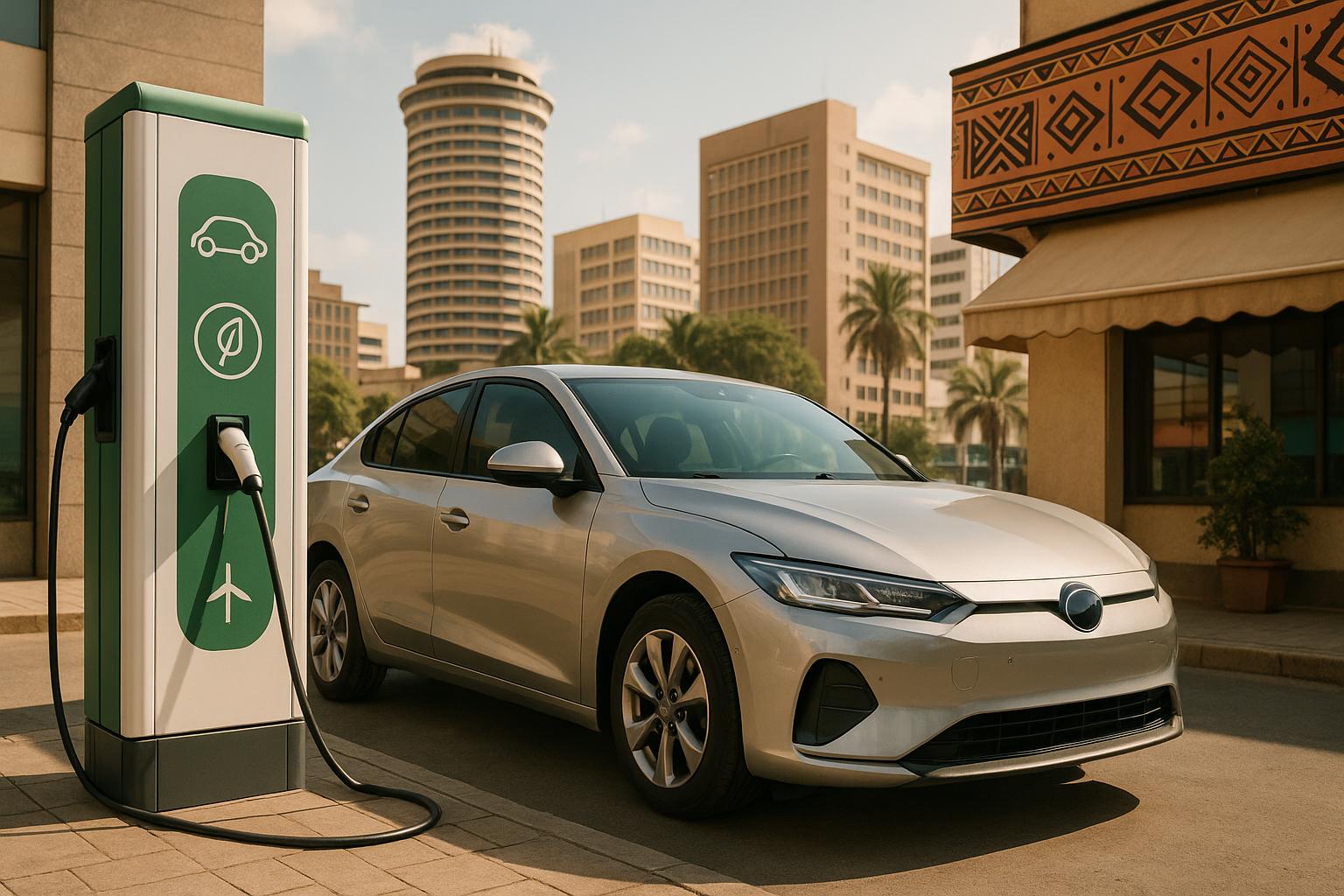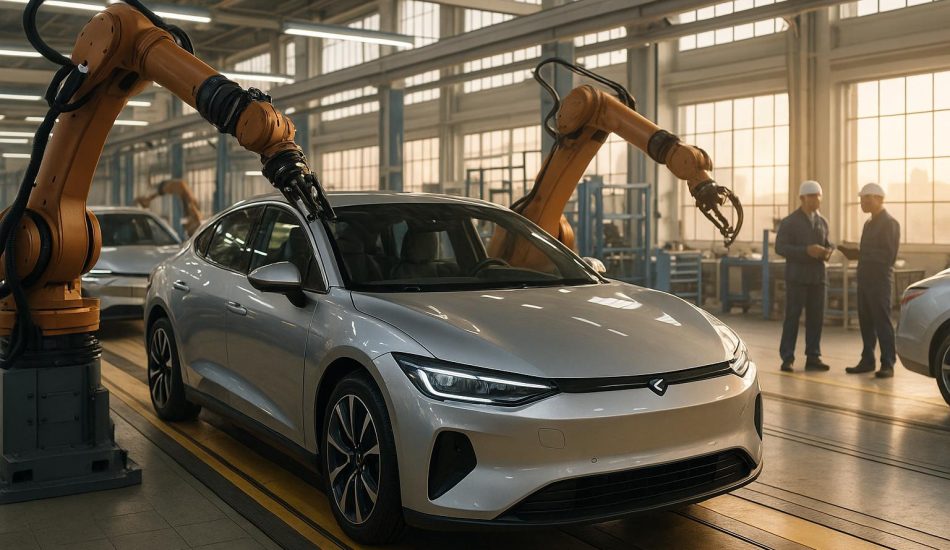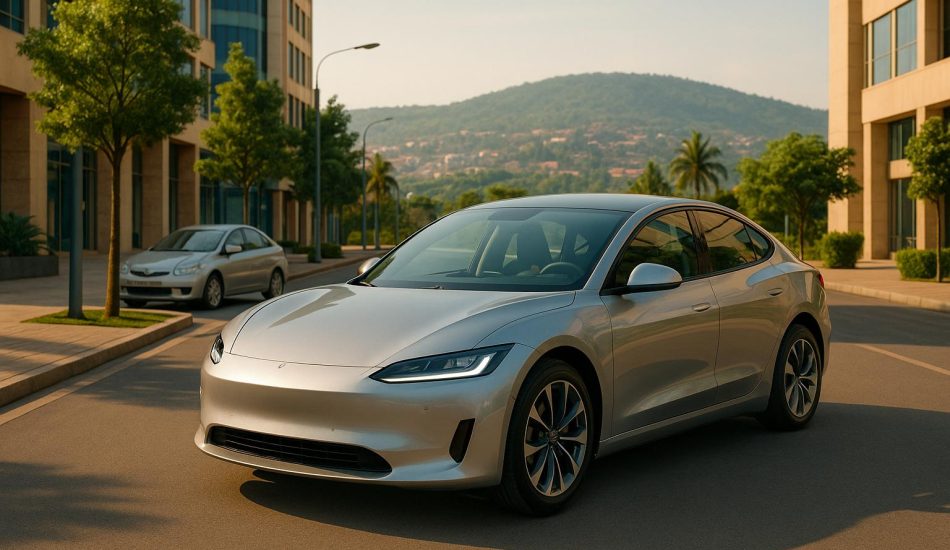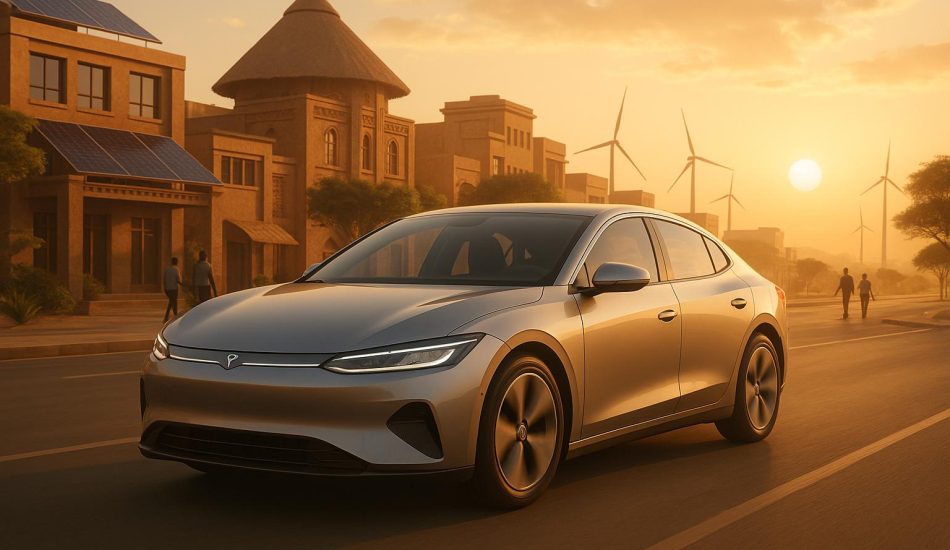
Kenya is taking bold steps to transform its transportation sector with its Electric Mobility Draft Policy, unveiled on March 27, 2024. The plan aims to reduce dependence on fossil fuels, cut greenhouse gas emissions, and promote electric vehicle (EV) adoption across all modes of transport. Here’s what you need to know:
- Why it matters: Kenya’s transport sector consumes 70% of petroleum products, contributing to high fuel import costs ($5.1 billion in 2022) and 11% of the country’s CO₂ emissions. The policy aligns with Kenya’s goal to cut emissions by 32% by 2030.
- Key targets: 5% of vehicles to be electric by 2025, scaling to 100% by 2050.
- Incentives: Reduced import duties (10%), lower excise taxes (10%), and a 0% VAT on EVs make them more affordable.
- Infrastructure: Plans include 10,000 charging stations by 2030, with Kenya Power investing $1.9 million in charging networks.
- Local manufacturing: Companies like Ecomobilus and Linncell Technologies are producing EVs locally, creating jobs and reducing reliance on imports.
This policy is not just about cleaner transport – it’s reshaping Kenya’s economy and energy use, leveraging its 90% renewable energy mix to power the shift to electric mobility.
Gov’t to deploy 10,000 EV charging units in the country by 2030
Main Features of Kenya’s Draft E-Mobility Policy
Kenya’s draft e-mobility policy, crafted by the Electric Mobility Taskforce (formed on August 4, 2023), outlines seven key pillars aimed at reshaping the nation’s transportation sector across various modes.
Goals and Objectives
The policy’s main goal is to replace internal combustion engine (ICE) vehicles with electric alternatives across all transport modes. This shift is designed to reduce greenhouse gas emissions and improve air quality. The urgency is clear: the transport sector is responsible for 11% of Kenya’s total CO₂ emissions and 67% of energy-related emissions, making it a major contributor to pollution.
Another central aim is to bolster energy security while fostering local manufacturing industries. Hon. Rebecca Miano, Cabinet Secretary of the Ministry of Investment, Trade & Industrialization, emphasized this point:
"To further support this sector, the Ministry (MITI) has developed an Automotive Policy to stimulate the assembly and manufacture of vehicles, with a specific focus on electric vehicles."
Public education is also a priority. The policy includes strategies to inform people about the advantages of electric mobility and the incentives available to them. These combined efforts set a strong foundation for Kenya’s transition to a more sustainable transport system.
Policy Targets and Timeline
The policy is built around clear milestones for electric vehicle (EV) adoption. By the end of 2025, Kenya aims to have 5% of its vehicles running on electricity. Looking further ahead, the country’s vision is to achieve 100% EV adoption by 2050, aligning with its pledge to cut CO₂ emissions by 32% by 2030 under its Nationally Determined Contribution.
This forward-thinking approach is already showing results, as the increasing number of EV registrations highlights the growing momentum behind this transition.
Tax Breaks and Financial Support
To meet these ambitious goals, the policy introduces a range of financial incentives designed to make EVs more affordable. These measures significantly lower the cost of owning an EV compared to traditional vehicles.
For instance, EVs enjoy reduced import duties (10% compared to up to 35%), lower excise duties (10% versus 20%), and a 0% VAT rate. These tax breaks can dramatically reduce costs. Take the Tesla Model 3, for example: priced at over $75,000 (about 10 million Kenyan shillings), such incentives make it a much more competitive option against similarly priced gasoline-powered luxury cars.
The policy also prioritizes the development of charging infrastructure, offering targeted incentives to support this critical area. Additionally, the government is working with financial institutions to provide affordable financing options, making EVs accessible to a broader audience.
Mr. Latiff Cherono, Chief Operations Officer at Gearbox Europlacer, highlighted the economic opportunities:
"Electric vehicles represent a high‑tech industry with strong value potential – owners of EVs or e‑motorbikes can earn profit margins of up to $700."
Beyond individual buyers, the policy encourages businesses to adopt electric vehicles. Companies like BasiGo are already benefiting, having secured $42 million in funding to roll out 1,000 electric buses across Kenya and Rwanda. Local manufacturers, such as Linncell Technologies Limited, are also gaining traction by developing specialized EV designs, including vehicles for individuals with disabilities and custom utility scooters.
Infrastructure Development and Market Preparation
Kenya is laying the groundwork for its electric vehicle (EV) future by improving its power grid, expanding charging networks, and fostering local EV manufacturing. These efforts are aimed at building the necessary infrastructure to support the country’s growing EV ecosystem.
Electric Grid Capacity
Nearly 90% of Kenya’s electricity comes from renewable energy sources, making EV charging a cleaner alternative compared to grids reliant on fossil fuels.
"With over 90 percent of our electricity grid powered by renewable energy, e-mobility remains central to our climate and economic agenda." – Alex Wachira, Principal Secretary in the State Department for Energy
In 2024, the government introduced regulations allowing private investment in transmission and distribution networks, accelerating grid expansion. Among these projects are four high-voltage power lines, valued at $371.58 million, slated for completion between 2026 and 2029. To address the 23% power loss reported in 2023, Kenya is exploring smart grid solutions to ensure efficient integration of EVs into the grid. These upgrades are timely, as EV registrations are projected to rise from 2,694 in 2023 to 5,294 in 2024, and further to 9,047 in 2025.
Charging Station Expansion
Both the government and private sector are working to expand EV charging infrastructure. Kenya Power, a major player in this space, plans to invest up to 258 million Kenyan shillings (around $1.9 million) over three years to deploy charging stations.
"The Government of Kenya is looking to install 10,000 charging stations in the country by 2030." – Joseph Siror, Kenya Power Managing Director
In the next year, Kenya Power aims to install 45 charging stations in six counties: Nairobi, Nyeri, Kisumu, Eldoret, Nakuru, Mombasa, and Taita Taveta. Six of these will be located at Jomo Kenyatta International Airport (JKIA), complementing the three chargers already operating in Nairobi. Additionally, the National Building Code 2024 mandates that 5% of parking spaces in commercial buildings be reserved for EV charging, with stations benefiting from discounted electricity tariffs. Kenya Power is also collaborating with GIZ and the Electric Mobility Association of Kenya (EMAK) to further expand infrastructure. As the charging network grows, local manufacturing efforts are stepping in to ensure the ecosystem remains sustainable.
Local Manufacturing and Training Programs
To reduce reliance on imports, Kenya is pushing for local EV assembly and component production. Policies now require greater local content in the EV value chain, fostering a shift toward domestic manufacturing.
Several companies are already making strides. Ecomobilus has developed the "eMkoko", a 500kg electric cargo cart inspired by the traditional Kenyan mkokoteni, with Kenyatta University’s Chandaria BIIC working to bring it to industrial-scale production. Linncell Technologies Limited is focusing on specialized EV designs, including vehicles for persons with disabilities and utility scooters for tasks like water and gas delivery. Meanwhile, Enviroserve is contributing to sustainability by operating an e-waste collection center and using lithium cell grading machines to recharge and assemble lithium batteries.
To address the skills gap, the government has introduced initiatives like the Recognition of Prior Learning (RPL) system, which formally certifies informally acquired skills, and the "Buy Kenya Build Kenya" initiative to bolster local technical expertise.
"Integrating e-mobility courses into technical schools and universities can facilitate the production of a competent workforce prepared to tackle obstacles the EV sector faces." – E-Safiri
Institutions such as Spiro Academy, AfricaNEV, Advanced Mobility, Strathmore University, and the Technical University of Kenya are stepping up with training programs, some of which include apprenticeship models to bridge skill gaps. However, challenges persist. Despite $148 million in investments by 2019, Kenya’s four main motor vehicle assemblers are operating at just 20% of their capacity, and the National Industrial Training Authority (NITA) has yet to establish a standardized curriculum for Technical Vocational Education and Training (TVET) specific to e-mobility.
sbb-itb-99e19e3
Effects on Consumers, Businesses, and the Economy
Kenya’s draft e-mobility policy is reshaping the transportation landscape, offering benefits that touch consumers, businesses, and the broader economy. By making electric vehicles (EVs) more accessible and fostering investment, the policy supports both individual and national goals.
Consumer Benefits
Kenyan consumers are seeing the financial appeal of EVs thanks to targeted incentives. The Finance Act of 2023 reduced excise duty on EVs from 20% to 10% and eliminated Value Added Tax (VAT) for fully electric vehicles. This has made EVs significantly more affordable. For instance, electric motorcycles – comprising nearly 90% of Kenya’s registered EVs – are priced between 180,000 and 300,000 Kenyan shillings ($1,350 to $2,250). Electric bicycles, on the other hand, cost between 80,000 and 120,000 Kenyan shillings ($600 to $900), depending on the make and model.
To further promote EV adoption, the Ministry of Roads and Transport has introduced green-colored license plates for all electric vehicles, including two-wheelers. This initiative not only raises awareness but also encourages more people to transition to e-mobility. These consumer-focused measures are paving the way for a broader transformation in transportation.
Business Opportunities
Kenya’s e-mobility policy is creating fertile ground for businesses, from startups to established players in the EV market. The country is positioning itself as a hub for EV assembly, with the government planning to establish 10,000 EV charging stations by 2030. The sector has already attracted significant investment: Roam secured $24 million in February 2024, while BasiGo raised $41.5 million in October 2024.
Financial institutions are also stepping up. In August 2022, NCBA Bank introduced a 2 billion Kenyan shilling ($15 million) loan facility to make EV purchases more accessible. Meanwhile, local manufacturing is gaining traction. Although Kenya’s current assembly plants produce over 11,000 internal combustion engine vehicles annually, the shift toward developing local expertise and intellectual property in EV technology is driving momentum for electric alternatives.
Economic and Environmental Effects
The ripple effects of Kenya’s e-mobility policy extend to the economy and the environment. Transportation accounts for 11% of Kenya’s total CO₂ emissions and 67% of energy-related emissions. Electrifying this sector is a crucial step toward the country’s goal of cutting net CO₂ emissions by 32% by 2030. With renewable energy making up 90% of Kenya’s power mix as of June 2024, EVs can operate on clean energy, reducing emissions and reliance on imported fossil fuels.
The shift to e-mobility is also driving job creation, particularly for young people. Opportunities range from manufacturing and vehicle assembly to installing and maintaining charging stations. This growing sector promises not only economic growth but also a reduced environmental footprint. Kenya’s efforts in adopting EVs have earned it recognition, ranking 7th among the top 10 African countries in this field.
Real Examples and Current Programs
Kenya’s e-mobility policy has sparked collaborations and initiatives that are translating government support into tangible business ventures and technological strides. Here’s a closer look at how partnerships, local manufacturing, and pilot programs are driving the country’s EV market forward.
Government-Business Partnerships
The Kenyan government is teaming up with private companies to push EV adoption through strategic collaborations. One standout example is the partnership between GreenMax Capital Group and MojaEV Africa, which launched a financing pilot program in Nairobi in June 2025. This initiative, aimed at taxi drivers, makes it easier to lease and eventually own Neta EVs – vehicles with a 350-kilometer (217-mile) range – by eliminating the traditional 20% down payment requirement. GreenMax contributed a $150,000 subordinated loan to MojaEV, covering 20% of the cost of 20 Neta EVs and incorporating this amount into lease payments. Members of the Drive Electric Group SACCO benefit from a simplified lease-transfer process after six months of timely repayments.
"This pilot is not just about cars – it’s about building pathways for inclusive finance, local bank engagement, and climate-smart livelihoods."
– Clifford Aron, President of GreenMax
Kenya Power is also playing a pivotal role, with e-mobility accounts now consuming 350,000 units of electricity, a threefold increase in demand. Dr. (Eng.) Joseph Siror, Managing Director and CEO of Kenya Power, highlighted their commitment to advancing this sector:
"The future of transport is electric, and as a Company, we are very excited to be leading the conversations around e-mobility."
– Dr. (Eng.) Joseph Siror, Kenya Power’s Managing Director and CEO
Boosting Local EV Production
Kenya’s emphasis on local manufacturing is paying off, with several companies setting up production facilities and creating innovative solutions. In 2022, Ampersand opened the country’s first electric motorcycle assembly plant, a move that not only supports local production but also creates jobs in the e-mobility space. These motorcycles, powered by renewable energy, help boda riders reduce their operational costs.
Ecomobilus has introduced the "eMkoko", a 500-kilogram (1,102-lb) electric cargo cart inspired by the traditional "mkokoteni" design. Kenyatta University’s Chandaria BIIC, in collaboration with the School of Engineering, is working to bring the eMkoko to industrial production standards. The vehicle incorporates locally assembled components, including the carry tray, chassis, and a lithium battery made from repurposed cells.
Linncell Technologies, led by a young entrepreneur with a disability, is designing EVs tailored for persons with disabilities and crafting custom utility scooters for water and gas delivery. The company has also installed a solar system to power its operations and charge two- and three-wheel EVs, showcasing the synergy between renewable energy and local EV production.
Transportation Cabinet Secretary Kipchumba Murkomen underscored the broader economic benefits of this local manufacturing push:
"The shift to electric vehicles significantly cuts emissions of greenhouse gases while reducing the petroleum import bill, currently standing at KES 628.4 billion ($4.8 billion). It will also promote local manufacturing and create jobs."
– Kipchumba Murkomen, Kenya’s transportation cabinet secretary
Pilot Programs and Regional Projects
Kenya is also testing various aspects of EV adoption through pilot programs, which provide critical insights for scaling up. In January 2022, Opibus introduced a 51-seater electric bus in Nairobi, pairing it with off-grid solar chargers. In another initiative, Siemens Stiftung and GIZ partnered with Ridelectric and Tumaini to pilot scalable e-mobility projects between 2023 and 2024, focusing on e-bicycles and electric utility vehicles. This followed a December 2021 agreement with Uber to supply 3,000 electric motorcycles.
These efforts are yielding measurable results. With 1.8 million motorcycles and mopeds in Kenya in 2021, compared to 1.2 million passenger cars, prioritizing electric two-wheelers is a strategic move to make the biggest impact in the transportation sector. These initiatives highlight how Kenya’s e-mobility policy is reshaping the market while advancing sustainable transportation.
Conclusion: Kenya’s Electric Vehicle Future
Kenya’s draft e-mobility policy lays out a strong plan for the country to take the lead in Africa’s electric vehicle (EV) movement. By combining tax incentives, infrastructure improvements, and support for local manufacturing, the policy reflects the growing readiness of the market to embrace EVs.
This shift isn’t just about technology – it brings environmental and economic benefits too. Transitioning to EVs significantly reduces CO₂ emissions and cuts fuel costs, aligning with Kenya’s pledge to lower greenhouse gas emissions by 32% by 2030. With its renewable energy resources, Kenya is uniquely positioned to adopt EVs as a sustainable transportation solution.
"The region’s policy frameworks are laying the foundation for ‘exponential’ growth in electric mobility, citing Kenya’s draft e-mobility policy as an example."
– John Msingo, Chief Revenue Officer at EVCharger
The focus on local manufacturing is already showing results, with companies like Ecomobilus and Linncell Technologies leading the way. Backed by supportive policies, these businesses are thriving. The government’s ambitious plan to establish 1,000 EV charging stations by 2027 addresses key infrastructure needs while boosting opportunities for local enterprises.
Investor interest is also growing, further fueling the sector’s momentum. As John Msingo highlights, "Investors are coming into the market. They see a gap." With this combination of government support, local innovation, and investor confidence, Kenya’s EV ecosystem is set to expand even further.
Whether you’re a consumer, a business, or an entrepreneur exploring Kenya’s evolving EV market through EV24.africa, the country’s policy framework is creating a landscape where adopting electric vehicles is not only feasible but also economically rewarding.
FAQs
What steps is Kenya’s draft e-mobility policy taking to support the shift from gas-powered vehicles to electric vehicles?
Kenya’s draft e-mobility policy aims to smooth the shift to electric vehicles (EVs) by tackling major obstacles like charging infrastructure, affordability, and energy reliability. Key initiatives include expanding EV charging networks, adjusting electricity tariffs to make charging more cost-effective, and strengthening energy reliability through decentralized systems.
The policy also prioritizes cutting greenhouse gas emissions and encouraging local EV production, setting Kenya up as a frontrunner in electric mobility on the African continent. By addressing high initial costs, fostering better collaboration between the government and private sector, and offering incentives for EV adoption, the plan creates a strong path toward a more sustainable transportation future in the region.
What incentives has the Kenyan government introduced to make electric vehicles more affordable for individuals and businesses?
The Kenyan government has rolled out various measures to make electric vehicles (EVs) more attainable and budget-friendly. One standout move is the sharp cut in import duties for fully electric vehicles, dropping the rate from 25% to 10%. EV users also benefit from tax breaks and reduced toll fees, easing the financial burden of switching to electric.
On top of that, the government is pouring resources into building charging infrastructure. This initiative aims to make the shift to electric mobility smoother and more practical for both individuals and businesses.
What is Kenya doing to build the infrastructure needed for electric vehicles, like charging stations?
Kenya is making strides in building its electric vehicle (EV) infrastructure, with plans to set up charging stations in key urban areas. Kenya Power has announced its intention to install 45 EV chargers in cities such as Nairobi, Kisumu, Mombasa, and Nakuru within the next year. Looking further ahead, the company aims to establish 10,000 chargers across the country by 2030.
In line with this, a draft e-mobility policy emphasizes the importance of a strong charging network, setting a target for electric vehicles to make up 5% of all registered vehicles in Kenya by 2025. These initiatives are part of a larger effort to encourage eco-friendly transportation and make EVs more accessible for both businesses and everyday drivers.




